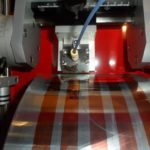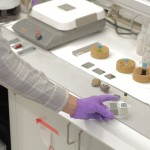Funding from the U.S. Department of Energy SunShot Initiative will help catalyze the development of next-generation solar cells at UW
October 22, 2014 -The cost of electricity from new solar cell installations is starting to compete with electricity from new coal and nuclear plants in sunny locations. Thanks to research at the University of Washington, the solar cells of the near future might be printed from inks and reach efficiencies more than double that of today’s typical solar cells, reducing the cost of electricity to below the level of even natural gas, the cheapest fossil fuel available now. They may even be able to compete with the low cost electricity from hydroelectric generation in cloudiest of locations in the Pacific Northwest.
UW professors Hugh Hillhouse and Alex Jen have been studying the factors that influence the cost of solar energy. The major factors that contribute to the cost of electricity from present day solar cells are the efficiency in converting sunlight to electricity, the cost of processing the materials and fabricating the devices, and the cost of assembling and installing solar cell systems.

Photovoltaic inks are use to print solar cells on a bench-top roll-to-roll coater at the University of Washington
Striving for high-efficiency and low-cost, Hillhouse and Jen have developed a method to fabricate a tandem, or “stacked,” solar cell by printing inks that yield materials with high bandgap and low bandgap on top of each other. The two materials work in tandem to generate more voltage and power than can be created with either material by itself. In particular, working with the UW Center for Commercialization, Hillhouse has patented unique device architectures that may allow these solar cells to reach 30% efficiency. By comparison current-day low-cost polycrystalline silicon solar modules are around 15% efficient. In addition, Jen has patented new materials and interface chemistry that allow key layers in the tandem to be printed. Working together, the team hopes to be able to print a new generation of high-efficiency low-cost solar cells.
Their initial research, funded in part by the UW Clean Energy Institute, helped the team win $1.5 million of funding from the Next Generation Photovoltaics 3 Program, which is part of the U.S. Department of Energy SunShot Initiative. The award was announced today at the Solar Power International conference in Las Vegas, Nevada.
To create this tandem solar cell, the UW team has engineered new molecular inks to form the top part of the tandem solar cell using a very promising new material called a hybrid perovskite. While the term “perovskite” refers to a large class of materials with the same crystal structure (named after the mineralogist Lev Perovski), these materials are quite different from conventional perovskites. These are hybrid organic-inorganic materials that are composed of organic cations that are regularly interspersed in an inorganic network of corner-sharing octahedra. The hybrid material is created using inexpensive compounds that are formed from elements that are distributed widely across the globe. While hybrid perovskites shared runner-up honors for Science Magazine’s “Breakthrough-of-the-Year” in 2013, new chemistry and new materials processing strategies need to be developed to make the perovskites more stable and increase their bandgap to work in the new tandem solar cells. The best materials are composed of six different elements. This means there is an incredibly large number of potential variations (including alloying, doping, and passivation). Discovering which variations are beneficial and understanding their physics and chemistry is a daunting task.

UW researchers are developing high-efficiency and low-cost “stacked” solar cells with two materials that work in tandem.
However, the UW team is uniquely positioned to uncover the secrets of this new, complex material. With support from the M.J. Murdock Charitable Trust, Hillhouse has developed a screening tool that allows them to print thousands of compositions and rapidly characterize their material properties. This allows them to quickly identify the most promising material combinations and focus scientific studies on those compositions. The SunShot award will support the UW team to focus on this task, which could play a major role on the growth and adoption of solar energy according to Hillhouse.
“This is the most exciting optoelectronic material discovered in over 40 years. The materials are polycrystalline, but their radiative efficiency is already better than silicon and almost as good as the best single crystalline gallium arsenide, which currently holds the record for the best single junction solar cell. If we can understand the basic physics, chemistry and engineering of these new perovskite materials, we could enable a new era of ultra low-cost high-efficiency solar cells. We can also apply the science and engineering to potentially develop higher bandgap perovskites that could even lead to a new class of LEDs for low-cost energy-efficient lighting.”
While the costs of solar energy systems have been dropping significantly over the past few years, it is due mostly to market forces like increased demand and manufacturing of photovoltaic (PV) systems, not the discovery of new low-cost manufacturing techniques or new device architectures. However, the materials and devices being developed by Hillhouse and Jen could lead to next generation solar technology that could be dramatically lower in cost to produce and install than the solar cells in the marketplace today, according to Jen.
“Fluctuating supply and demand cycles can be unsustainable for developing technologies for markets like renewable energy, so advances in research and technology are needed to ensure that the gains in solar affordability remain sustainable long term,” Jen said. “When we can cross the valley from scientific research to technology translation we believe these printable, tandem solar cells have the potential to be produced at large volume with a low-cost manufacturing process to address the scalability challenges.”
The UW team will use the grant from the U.S. Department of Energy SunShot Initiative to expand its research, discover new chemistry and processing, and develop a proof-of-concept prototype.
###
Hugh Hillhouse is the Rehnberg Chair Professor of Chemical Engineering at the UW.
Alex K.Y. Jen is the Boeing-Johnson Chair Professor and Chairman of the Department of Materials Science & Engineering at the UW. He is also the Chief Scientist responsible for Science and Technology Integration for the Clean Energy Institute.
About the SunShot Initiative
The U.S. Department of Energy SunShot Initiative is a collaborative national effort that aggressively drives innovation to make solar energy fully cost-competitive with traditional energy sources before the end of the decade. Through SunShot, the Energy Department supports efforts by private companies, universities, and national laboratories to drive down the cost of solar electricity to $0.06 per kilowatt-hour. Learn more at energy.gov/sunshot.




